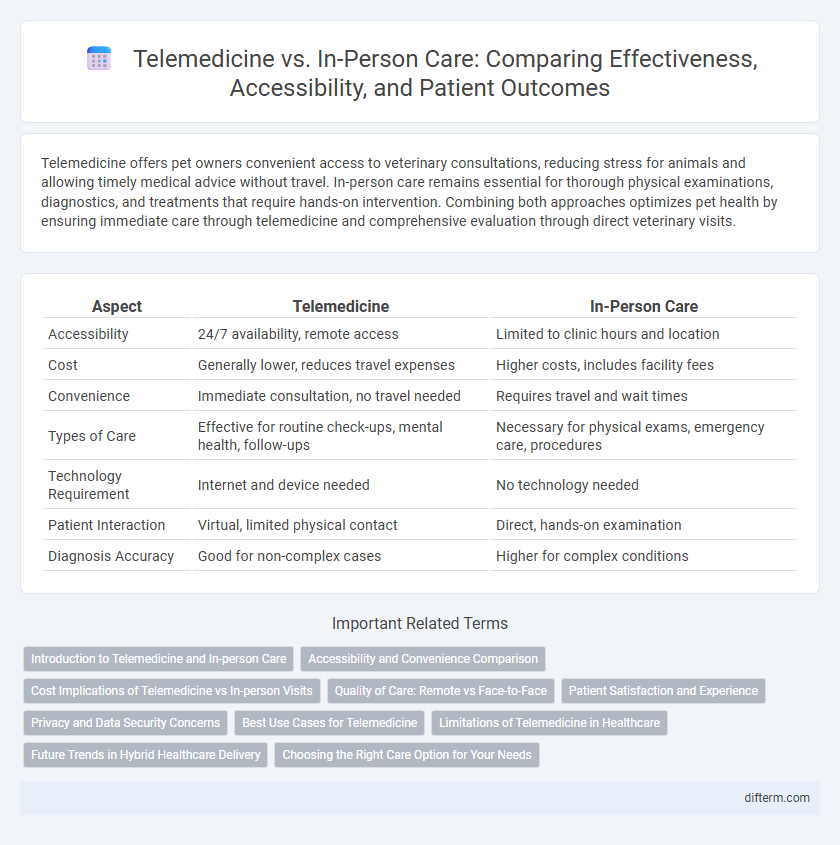Telemedicine offers pet owners convenient access to veterinary consultations, reducing stress for animals and allowing timely medical advice without travel. In-person care remains essential for thorough physical examinations, diagnostics, and treatments that require hands-on intervention. Combining both approaches optimizes pet health by ensuring immediate care through telemedicine and comprehensive evaluation through direct veterinary visits.
Table of Comparison
| Aspect | Telemedicine | In-Person Care |
|---|---|---|
| Accessibility | 24/7 availability, remote access | Limited to clinic hours and location |
| Cost | Generally lower, reduces travel expenses | Higher costs, includes facility fees |
| Convenience | Immediate consultation, no travel needed | Requires travel and wait times |
| Types of Care | Effective for routine check-ups, mental health, follow-ups | Necessary for physical exams, emergency care, procedures |
| Technology Requirement | Internet and device needed | No technology needed |
| Patient Interaction | Virtual, limited physical contact | Direct, hands-on examination |
| Diagnosis Accuracy | Good for non-complex cases | Higher for complex conditions |
Introduction to Telemedicine and In-person Care
Telemedicine leverages digital technology to provide remote healthcare services, enabling virtual consultations, diagnosis, and treatment through smartphones, computers, and other devices. In-person care involves direct, face-to-face interactions between patients and healthcare providers, allowing for physical examinations, immediate diagnostic testing, and hands-on treatments. Both methods aim to improve patient outcomes, with telemedicine enhancing accessibility and convenience, while traditional in-person care ensures comprehensive clinical assessments.
Accessibility and Convenience Comparison
Telemedicine significantly enhances healthcare accessibility by providing remote consultations, eliminating travel barriers for patients in rural or underserved areas. Convenience is improved through flexible scheduling, reduced wait times, and the ability to receive care from home, which is particularly beneficial for chronic disease management. In-person care remains essential for physical examinations and complex procedures but often requires more time and logistical arrangements, impacting overall patient convenience.
Cost Implications of Telemedicine vs In-person Visits
Telemedicine reduces healthcare costs by eliminating expenses related to travel, facility fees, and time off work, resulting in significant savings for patients and providers. In-person visits often incur higher overhead costs, including staff, equipment, and physical space maintenance, driving up overall healthcare expenditure. Cost analyses indicate telemedicine can lower per-visit costs by up to 31%, making it a financially sustainable option for routine consultations and chronic disease management.
Quality of Care: Remote vs Face-to-Face
Telemedicine offers improved access to healthcare through virtual consultations, enabling timely diagnosis and treatment, though it may face limitations in conducting physical examinations compared to in-person care. Face-to-face visits provide comprehensive clinical assessments and direct patient-provider interaction, which can enhance diagnostic accuracy and personalized treatment planning. Studies show that while telemedicine maintains high satisfaction and quality for chronic disease management and follow-ups, complex cases often benefit from the nuanced evaluation available only through in-person care.
Patient Satisfaction and Experience
Telemedicine offers patients increased convenience and accessibility, leading to high satisfaction rates especially in managing chronic conditions and routine check-ups. In-person care provides comprehensive physical examinations and immediate diagnostic testing, enhancing the patient experience for complex or acute health issues. Studies indicate that patient satisfaction in telemedicine is closely tied to technology usability and provider communication quality, while in-person visits are valued for personalized interaction and hands-on treatment.
Privacy and Data Security Concerns
Telemedicine platforms employ advanced encryption protocols and secure data storage to protect patient information, yet they remain vulnerable to cyberattacks and data breaches. In-person care typically offers greater control over physical records and reduces risks associated with digital data transmission but may still encounter privacy challenges through unauthorized access in healthcare facilities. Ensuring compliance with HIPAA and other regulatory frameworks is crucial for both telemedicine and traditional healthcare to safeguard patient confidentiality and data security.
Best Use Cases for Telemedicine
Telemedicine excels in managing chronic conditions such as diabetes and hypertension by enabling regular remote monitoring and timely medication adjustments. Mental health services benefit significantly from virtual consultations, offering increased accessibility and privacy for patients. Remote triage and follow-up visits also optimize healthcare resources by reducing unnecessary in-person appointments while maintaining high-quality patient care.
Limitations of Telemedicine in Healthcare
Telemedicine faces limitations including reduced physical examination capabilities, which can hinder accurate diagnosis and treatment of complex conditions. Technical issues such as internet connectivity and device incompatibility may disrupt patient-provider communication, impacting care quality. Privacy concerns and regulatory restrictions also limit telemedicine's widespread adoption in sensitive healthcare scenarios.
Future Trends in Hybrid Healthcare Delivery
Telemedicine and in-person care are converging in hybrid healthcare delivery models, leveraging real-time remote monitoring, AI-driven diagnostics, and personalized treatment plans to enhance patient outcomes. Emerging technologies like 5G connectivity and wearable health devices enable seamless integration between virtual consultations and face-to-face visits. Healthcare systems are increasingly adopting hybrid models to improve access, reduce costs, and ensure continuity of care in chronic disease management and preventive medicine.
Choosing the Right Care Option for Your Needs
Telemedicine offers convenient access to healthcare services, especially for non-emergency consultations, chronic disease management, and mental health support, while in-person care remains essential for physical examinations, diagnostic tests, and urgent medical conditions. Patients should evaluate factors such as the severity of symptoms, need for hands-on evaluation, and access to medical technology when deciding between telemedicine and in-person visits. Personalized care decisions optimize treatment outcomes by aligning medical needs with the most effective care delivery method.
Telemedicine vs In-person care Infographic

 difterm.com
difterm.com